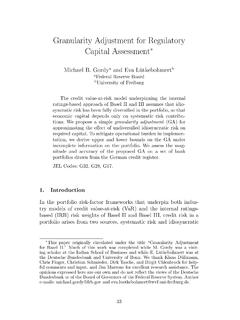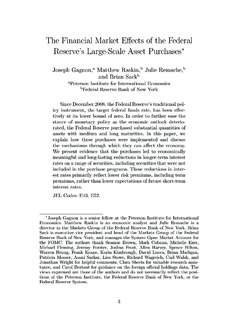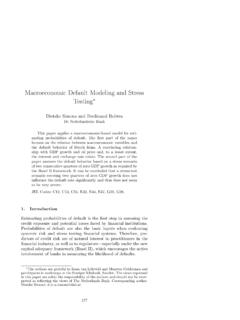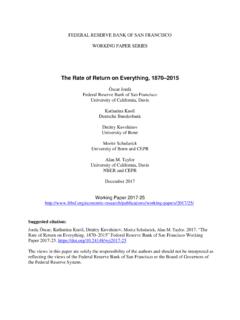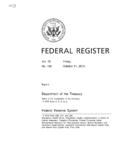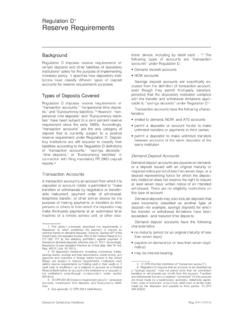Transcription of Estimated Impact of the Federal Reserve’s …
1 Estimated Impact of the Federal reserve 's mortgage - backed securities purchase Program . Johannes Stroebel and John B. Taylor Stanford University The largest credit or liquidity program created by the Federal reserve during the nancial crisis was the mortgage - backed securities (MBS) purchase program. In this paper, we examine the quantitative Impact of this program on mortgage interest rate spreads. This is more di cult than frequently per- ceived because of simultaneous changes in prepayment risk and default risk. Our empirical results attribute a sizable portion of the decline in mortgage rates to such risks and a relatively small and uncertain portion to the program. For speci cations where the existence or announcement of the program appears to have lowered spreads, we nd no separate e ect of the stock of MBS purchased by the Federal reserve .
2 JEL Codes: E52, E58, G01. 1. Introduction As part of its response to the nancial crisis, the Federal reserve introduced a host of new credit and liquidity programs in 2008 and 2009. The largest of the new programs was the mortgage - backed securities (MBS) purchase program. This program was part of a quantitative easing or credit easing policy which replaced the usual tool of monetary policy the Federal funds rate when it hit the lower bound of zero. The mortgage - backed securities that the Fed- eral reserve purchased were guaranteed by Fannie Mae and Freddie . We would like to thank Jim Dignan, Darrell Du e, Peter Frederico, Frank Nothaft, Eric Pellicciaro, Josie Smith, and two anonymous referees for helpful comments. Author e-mails: and 1. 2 International Journal of Central Banking June 2012.
3 Mac, the two government-sponsored enterprises (GSEs) with this role, as well as by Ginnie Mae, the government-owned corpo- ration within the Department of Housing and Urban Development. The program was set up with an initial limit of $500 billion but was later expanded to $ trillion. It expired on March 31, 2010. The Federal reserve also created a program to buy GSE debt . initially up to $100 billion and later expanded to $200 billion and a program to purchase $300 billion of medium-term Treasury secu- rities. The Federal reserve 's MBS purchases came on top of an earlier-announced MBS purchase program by the Treasury. These programs were introduced with the explicit aim of reducing mortgage interest Figure 1 shows both primary and secondary mortgage interest rate spreads over Treasury yields during the nan- cial crisis.
4 Primary mortgage rates are the rates that are paid by the individual borrower. They are based on the secondary market rate but also include a fee for the GSE insurance, a servicing spread to cover the cost of the mortgage servicer, and an originator spread. Observe that mortgage spreads over Treasuries started rising in 2007 and continued rising until late 2008, when they reached a peak and started to decline. By July 2009 they had returned to their long-run average, or to slightly below that average. In this paper we consider to what degree the decline in spreads in 2009 can be attributed to the purchases of mortgage - backed secu- rities by the Federal reserve and the Treasury. This question is very important for deciding whether or not to use such programs in the future as a tool of monetary policy.
5 Determining whether central banks have the ability to a ect the pricing of mortgage securities for extended periods is also an important input into the debate about the role, responsibilities, and powers of central banks (see, for exam- ple, the collection of essays on this subject in Ciorciari and Taylor 2009), and we see this paper as part of a larger empirical analysis of quantitative easing, or credit easing, at central banks during the crisis. 1. The press release on November 25, 2008 announcing the MBS purchase pro- gram stated that this action is being taken to reduce the cost and increase the availability of credit for the purchase of houses, which in turn should sup- port housing markets and foster improved conditions in nancial markets more generally.. Vol. 8 No. 2 Estimated Impact 3.
6 Figure 1. mortgage Spreads and Stock of MBS Purchases Notes: This gure shows the primary market mortgage spread, the secondary market mortgage spread, and the total stock of MBS purchases by the Fed- eral reserve and Treasury. The primary market mortgage rate series comes from Freddie Mac's Primary mortgage Market Survey, which surveys lenders each week on the rates and points for their most popular thirty-year xed- rate, fteen-year xed-rate, 5/1 hybrid amortizing adjustable-rate, and one-year amortizing adjustable-rate mortgage products. The secondary market mortgage series is the Fannie Mae thirty-year current-coupon MBS (Bloomberg ticker: ). The spreads are created by subtracting the yield on ten- year Treasuries from both series. The maturity di erence between these series captures the fact that most thirty-year mortgages are paid o or re nanced before their maturity.
7 We add MBS to the total stock when they are contracted and reported by the Federal reserve Bank of New York, not when they appear on the Federal reserve 's balance sheet. A common perception is that the MBS purchase program led to a signi cant reduction in mortgage rates. For example, early in the program, in January 2009, Ben Bernanke (2009) noted that mort- gage rates dropped signi cantly on the announcement of this pro- gram and have fallen further since it went into operation. Later, in December 2009, Brian Sack (2009) of the Federal reserve Bank of New York reiterated that view. Figure 1 shows that the decline in the 4 International Journal of Central Banking June 2012. mortgage interest rate spread was contemporaneous to the expan- sion of the MBS purchase Some also cite the large fraction of new agency-insured MBS issuance that the Federal reserve has purchased each month since the start of the purchase Figure 2 shows that MBS purchases in 2009 were up to 200 per- cent of new issuance of GSE-insured debt, and a signi cantly larger fraction of net issuance.
8 In our view, however, an evaluation of the program's Impact requires an econometric analysis that controls for in uences other than the MBS purchase program on mortgage spreads. In particu- lar, any coherent story that links the decline in mortgage interest rates to the purchases of MBS by the Federal reserve also needs to explain why mortgage spreads increased so dramatically between 2007 and late 2008, and consider whether those same factors may be responsible for at least part of the subsequent decline in 2009. It is conceivable that precisely those indicators of risk in mortgage lend- ing that drove up mortgage spreads through 2007 and 2008 relaxed 2. MBS purchases are primarily made in the to be announced (TBA) market in which the pool identity is unknown at the time of the purchase .
9 The TBA. contract de nes the MBS that will be delivered only by the average maturity and coupon of the underlying mortgage pool, and by the GSE backing the MBS. For example, an investor might purchase $1 million worth of 8 percent, thirty- year Fannie Maes for delivery next month. Precise pool information is then to be announced forty-eight hours prior to the established trade settlement. This allows a lender to lock in the rate they can o er the mortgage borrowers by pre- selling their loans to investors, and thus to fund their origination pipeline. For more details on this market, see Boudoukh et al. (1999). The Federal reserve Bank of New York announced MBS purchases when they contracted to buy;. the Federal reserve placed the MBS on its balance sheet (reported in the release) when the contract settled.
10 This explains why at the end of the MBS pur- chase program, on March 31, 2010, the Federal reserve had just over $1 trillion of MBS on its balance sheet, rather than $ trillion, which is the overall size of the program. In this paper we record the volume of purchases when they are con- tracted and reported by the Federal reserve Bank of New York, not when they appear on the Federal reserve 's balance sheet. A robustness check has shown that this does not a ect our conclusions. 3. This point was also made by Sack (2009): How has the Federal reserve been able to generate these substantial e ects on longer-term interest rates? One word: size. The total amount of securities to be purchased under the LSAPs is quite large relative to the size of the relevant markets. That is particularly the case for mortgage - backed securities .

